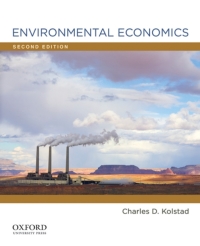Consider a pollution problem involving a paper mill located on a river and a commercial salmon fishery
Question:
Consider a pollution problem involving a paper mill located on a river and a commercial salmon fishery operating on the same river. The fishery can operate at one of two locations: upstream (above the mill) or downstream (in the polluted part of the river). Pollution lowers profits for the fishery: without pollution, profits are \(\$ 300\) upstream and \$500 downstream; with pollution, profits are \$200 upstream and \(\$ 100\)
downstream. The mill earns \(\$ 500\) in profit, and the technology exists for it to build a treatment plant at the site that completely eliminates the pollution, but at a cost of \(\$ 200\). There are two possible assignments of property rights: (i) the fishery has the right to a clean river and (ii) the mill has the right to pollute the river.
a. What is the efficient outcome (the maximum of total joint profit)?
b. What are the outcomes under the two different property rights regimes, when there is no possibility of bargaining?
c. How does your answer to (b) change when the two firms can bargain costlessly?
Step by Step Answer:






